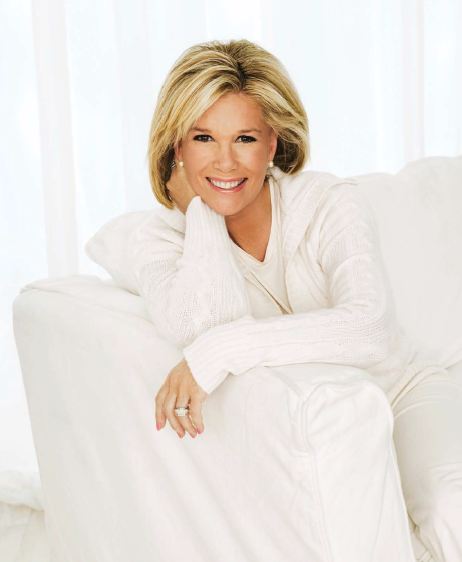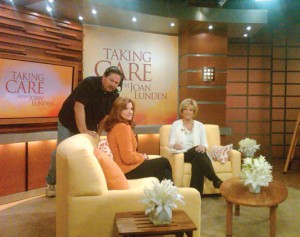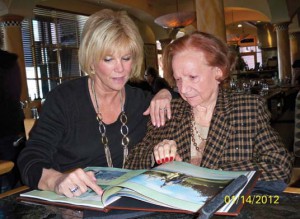For 17 years, Joan Lunden woke the country up as the co-host of Good Morning America. Now, the award-winning journalist and mom of seven is giving America a new wake-up call. As a spokesperson, host of a TV series, and co-author of the recently released Chicken Soup for the Soul: Family Caregivers, Joan is spreading awareness about dementia, which affects her 93-year-old mother, Gladyce.
Preserving Your Memory magazine spoke with Joan about her role in educating families affected by dementia and caring for her mother from afar.

Preserving Your Memory: Can you describe your initial reaction to your mother’s diagnosis?
Joan Lunden: It’s interesting because dementia is not like you go in and they find cancer somewhere in your body. It happens little by little. Forgetful becomes frightful. Somebody would walk up and say, “Hi Glady.” And my mom would look at them and not have a clue as to who they were. Sometimes you can say, “She hasn’t seen that person in 10 years.” But then she didn’t remember the people who were taking care of her on a daily basis. We all tend to want to stick our heads in the sand because we want them to stay as they used to be. But it’s really more the realization. At some point you have to finally acknowledge it.
PYM: Your mother and your brother, who had type 2 diabetes, lived in a condo together. After your brother passed, you went to pack your mother’s things because she couldn’t live alone. You had trouble finding her driver’s license, social security card, even accessing her bank account.
JL: I don’t know what the explanation is, but almost everybody’s home you go into that’s older, they tend to keep everything. I went in and there must have been ten thousand pieces of paper, just not the important ones. When I asked about her driver’s license, she said, “I don’t know. You know I stopped driving a long time ago.” “Okay, where’s your Social Security card?” Her response was, “I don’t know. I don’t take care of that anymore.” I couldn’t find anything.
PYM: What steps do you think caregivers and future caregivers need to take so they don’t face a similar situation?
JL: You should have a copy of your parents’ (and even your spouse’s) driver’s license and passport. You should know where their health and life insurance papers are, the mortgage or rental agreement to where they live, and the car title. You also need to have a legal and medical power of attorney so you can act on their behalf, a HIPAA release so medical institutions can release information to you, an advanced healthcare directive, otherwise known as a living will, and you need to know whether they have advanced long-term healthcare insurance.
PYM: Deciding when (or whether) to place a loved one in assisted living is difficult. What advice would you give to families struggling with this decision?
JL: There comes a time when you have to say, “What’s the safe thing to do for my parent?” A lot of people say, “My folks are going to stay right where they are until the end.” It’s wonderful when you can do it, but you have to really come to terms and acknowledge when you can’t leave them in that situation for their own good.
PYM: Your mother moved to a few different facilities. Tell us about the moves.
JL: The first place had a beautiful dining room and she had her own one-bedroom apartment. The only problem was it was probably the perfect place for my mom about 10, 15 years ago. She hadn’t lived alone in a long time and didn’t want to, was fearful of it. She also had what’s called “sundown syndrome,” so when the sun started to set and the shadows started changing, she would come unglued. I found another place that gave more care but it still wasn’t enough because she would get out of bed and fall. After three or four falls, the doctors said, “You can’t put her back in this kind of setting. She needs around-the-clock care.” That’s where she is now.
PYM: Any tips to make moves easier for loved ones?
JL: Moving completely disconnects them from their reality one more time and they’re in a new place, everything is situated in a new way. The last time we moved my mom, my daughter Lindsay went out with me and she had this fantastic idea to photograph everything in mom’s old room. When we moved her into the new place, we looked at those pictures and put everything back as best as we could. It seemed to be less disconcerting to mom.
PYM: You’ve mentioned experts helped you get a better handle on things. What kind of experts did you find to be helpful?
JL: I got an elder lawyer in Sacramento where my mom lives. It didn’t cost much. You’re not talking about thousands of dollars. It was hundreds of dollars. She was able to help me put together the important documents I needed.

PYM: Taking Care with Joan Lunden is running on RLTV. How did the idea for this series come about?
JL: We do this as a joint project between AARP and RLTV, but they came to me because they’d read a story somewhere and knew of my mom’s situation. Doing a program like this, interviewing different experts and real families going through the journey, it helps when you’ve done it yourself and know the frustrations, roadblocks, and questions to ask. Now I speak all over the country about this.
PYM: Taking Care focuses on many aspects of caregiving. One thing it addresses is different types of senior housing. Did you struggle when finding a place for your mom?
JL: Each time I’d gone out to Sacramento, I’d get in a car, look around, and ask people for word-of-mouth recommendations. I think back on it now. If I wanted to buy a house, would I have gotten in my car, driven around the neighborhood and looked? Never in a million years. I would’ve called a realtor. I would have gotten a professional to help me. Yet, when you’re presented with these issues as a caregiver, it’s a frustrating and frightening feeling.
PYM: You’re a spokesperson for A Place for Mom, a senior living referral service. Can you tell me about the service? Any tips for caregivers navigating the world of senior housing?
JL: A Place for Mom helped me get my last place, the place that was finally right for my mom. They told me about the places available in the area, the pros and cons of each one, and they took me to see them. They also walk into a place and ask questions you’re not inclined to ask. I never would have walked into the kitchen and opened the refrigerator to see if they cook fresh food or give them frozen TV dinners. I never would’ve walked into someone else’s bedroom or bathroom to see how clean it was. But those are the things you need to do. And they do it. And it doesn’t cost you anything.
PYM: Your mom lives on the West Coast while you live on the East Coast. What are some of the challenges of long-distance caregiving?
JL: Guilt. Guilt that you’re not there on a daily basis. However, a move wouldn’t be advisable for my mom. And I don’t live here in New York all the time. I live three months in another place. My mom can’t go back and forth between places. Plus, she still has a number of friends where she lives that come by and see her, and here she would have no one. It would just be me.
PYM: How do you keep in touch with her?

JL: I visit every five or six weeks. And I keep a good relationship with the people who are in charge of her care. If you sit and talk with the people who take daily care of your loved one, they have more information to make your loved one more comfortable on a daily basis. I talk about what mom was like growing up, what my dad was like, what we were all like as a family, where she lived in the area, and it allows them to come up with all kinds of information to connect her with life as she knew it. I also send little things. When I go out of town, I’ll pick a postcard, quickly address it to her, and say, “Hi from Philadelphia!” Or I’ll send a magazine with a little paper clip and piece of paper in there that says, “Hi, Mom. Thought you’d enjoy this article.” It means she gets mail, opens it, and there’s a connection to me.
PYM: You’re part of the ‘sandwich generation’ — caring for children while also caring for a parent. How difficult is it to maintain balance, especially with your career?
JL: It’s very difficult. It’s said the average caregiver is a woman who is 49 years old and still caring for kids, whether they’re in the home or you’re financing them through college, and you have a job outside the home, and now you’re caring for a loved one. It all adds up. It’s enough to take anyone down.
PYM: What advice would you give to others in this situation?
JL: Get support, whether it’s online support, through your local church, or a program in your area. If there are other siblings around, ask them for help as well. You have to seek help and advice so that you don’t totally burn out.
PYM: How is your mom doing now?
JL: She’s actually doing okay. My mom doesn’t have any kind of actual health problem, like high blood pressure or anything. The dementia is really the one overriding factor. But she’s happy where she is. They take fantastic care of her. It’s great to put my head on my pillow and go to sleep with peace of mind that the people who are with my mom are compassionate, kind, and smile at her from morning to night. Therefore, I take my hat off to all caregivers who do that on a daily basis, whether it’s at home with a loved one or at a facility taking care of the older people in our country. That, to me, is priceless.
By Tamekia Reece










